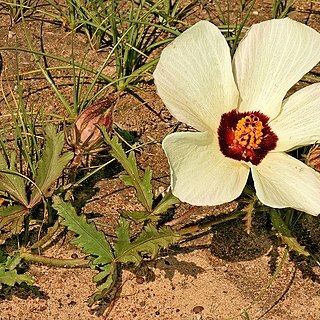Perennial herb, 50-300 mm high. Leaves with blade undivided to deeply 3-5 palmatisect, 50-60 x 20-45 mm, nearly glabrous to hispid, lobes narrowly elliptic to sharply toothed or pinnatifid. Flowers: epicalyx with > 5 segments; petals 10-45 mm long, yellow (rarely pink) with purple or crimson centre; Sep.-May. Seeds with a silky or cottony floss at maturity.
Glabrescent subshrub with slender branches to 60 cm, from woody rootstock. Leaves 3-5-palmatisect, lobes linear-oblong, usually toothed. Flowers axillary, on long peduncles, cream-coloured to yellow or pink, sometimes with dark eye, calyx lobes attenuate, epicalyx of 10-12 linear lobes, staminal tube 4-8 mm long; seeds with silky floss.
Leaf-lamina 5–6 × 2–4·5 cm., suborbicular to elliptic in outline, not lobed to deeply 3–5-palmatisect, nearly glabrous to hispid, especially on the nerves of the lower surface; lobes narrowly elliptic to sharply toothed or pinnatifid; petiole 2–15 mm. long; stipules 5–7 mm. long, subulate.
Perennial herb, 50-300 mm tall. Leaves not lobed to deeply 3-5-palmatisect, nearly glabrous to hispid, lobes narrowly elliptic to sharply toothed or pinnatifid. Petals 10-45 mm long. Flowers yellow (rarely pink) with purple or crimson centre.
Flowers up to 6 cm. in diam., yellow (rarely pink) with a purple or crimson centre, usually solitary, axillary; peduncle 1·5–12 cm. long, inconspicuously articulated near the apex.
Perennial herb 5–30 cm. high with ± prostrate annual shoots from a woody rootstock; stems hispid or with appressed stellate hairs or a mixture of patent and oppressed hairs.
Petals 1–4·5 cm. long, obovate, nearly glabrous or with a few scattered stellate hairs.
Calyx up to 25 mm. long; lobes 7–25 × 3–8 mm., narrowly lanceolate-triangular, acute.
Seeds with a well-developed white, brownish or reddish silky floss.
Staminal tube 4–8 mm. long; free parts of filaments 4–8 mm. long.
Capsule 10–12 × 10–12 mm., hispid on the margins of the valves.
Epicalyx of 8–11 bracts; bracts 3–12 mm. long, acicular.
Style-branches 2·5–4 mm. long.

